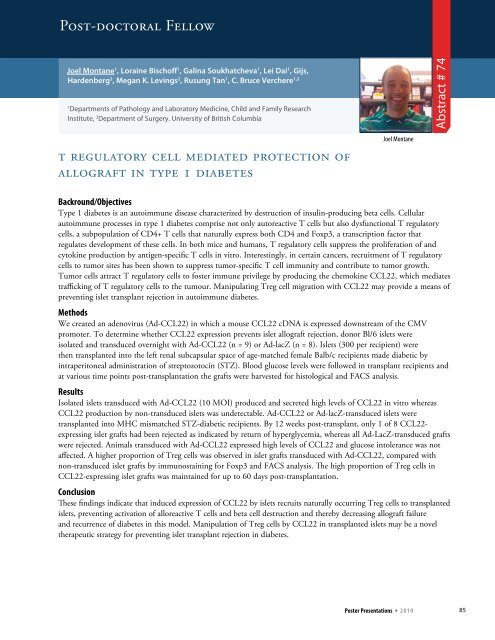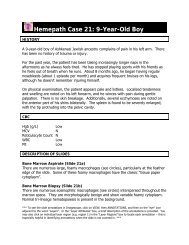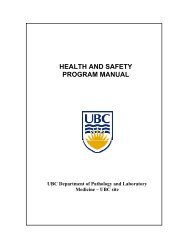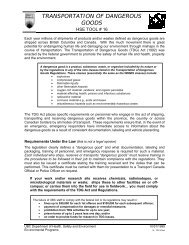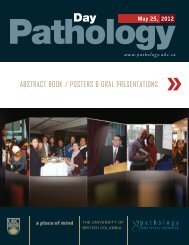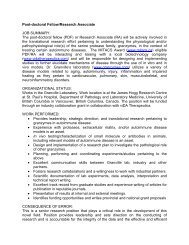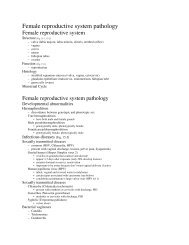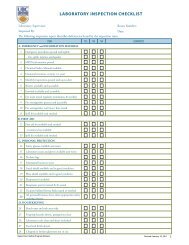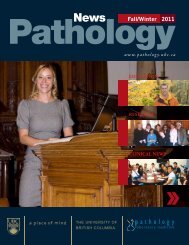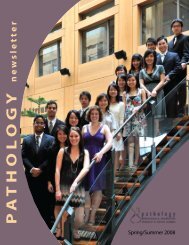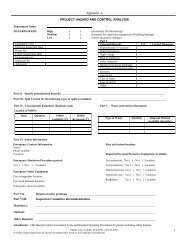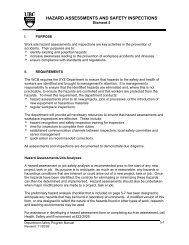Oral Presentations - Pathology and Laboratory Medicine - University ...
Oral Presentations - Pathology and Laboratory Medicine - University ...
Oral Presentations - Pathology and Laboratory Medicine - University ...
You also want an ePaper? Increase the reach of your titles
YUMPU automatically turns print PDFs into web optimized ePapers that Google loves.
Post-doctoral FellowJoel Montane 1 , Loraine Bischoff 1 , Galina Soukhatcheva 1 , Lei Dai 1 , Gijs,Hardenberg 2 , Megan K. Levings 2 , Rusung Tan 1 , C. Bruce Verchere 1,21Departments of <strong>Pathology</strong> <strong>and</strong> <strong>Laboratory</strong> <strong>Medicine</strong>, Child <strong>and</strong> Family ResearchInstitute, 2 Department of Surgery. <strong>University</strong> of British ColumbiaAbstract # 74t regulatory cell mediated protection ofallograft in type 1 diabetesJoel MontaneBackround/ObjectivesType 1 diabetes is an autoimmune disease characterized by destruction of insulin-producing beta cells. Cellularautoimmune processes in type 1 diabetes comprise not only autoreactive T cells but also dysfunctional T regulatorycells, a subpopulation of CD4+ T cells that naturally express both CD4 <strong>and</strong> Foxp3, a transcription factor thatregulates development of these cells. In both mice <strong>and</strong> humans, T regulatory cells suppress the proliferation of <strong>and</strong>cytokine production by antigen-specific T cells in vitro. Interestingly, in certain cancers, recruitment of T regulatorycells to tumor sites has been shown to suppress tumor-specific T cell immunity <strong>and</strong> contribute to tumor growth.Tumor cells attract T regulatory cells to foster immune privilege by producing the chemokine CCL22, which mediatestrafficking of T regulatory cells to the tumour. Manipulating Treg cell migration with CCL22 may provide a means ofpreventing islet transplant rejection in autoimmune diabetes.MethodsWe created an adenovirus (Ad-CCL22) in which a mouse CCL22 cDNA is expressed downstream of the CMVpromoter. To determine whether CCL22 expression prevents islet allograft rejection, donor Bl/6 islets wereisolated <strong>and</strong> transduced overnight with Ad-CCL22 (n = 9) or Ad-lacZ (n = 8). Islets (300 per recipient) werethen transplanted into the left renal subcapsular space of age-matched female Balb/c recipients made diabetic byintraperitoneal administration of streptozotocin (STZ). Blood glucose levels were followed in transplant recipients <strong>and</strong>at various time points post-transplantation the grafts were harvested for histological <strong>and</strong> FACS analysis.ResultsIsolated islets transduced with Ad-CCL22 (10 MOI) produced <strong>and</strong> secreted high levels of CCL22 in vitro whereasCCL22 production by non-transduced islets was undetectable. Ad-CCL22 or Ad-lacZ-transduced islets weretransplanted into MHC mismatched STZ-diabetic recipients. By 12 weeks post-transplant, only 1 of 8 CCL22-expressing islet grafts had been rejected as indicated by return of hyperglycemia, whereas all Ad-LacZ-transduced graftswere rejected. Animals transduced with Ad-CCL22 expressed high levels of CCL22 <strong>and</strong> glucose intolerance was notaffected. A higher proportion of Treg cells was observed in islet grafts transduced with Ad-CCL22, compared withnon-transduced islet grafts by immunostaining for Foxp3 <strong>and</strong> FACS analysis. The high proportion of Treg cells inCCL22-expressing islet grafts was maintained for up to 60 days post-transplantation.ConclusionThese findings indicate that induced expression of CCL22 by islets recruits naturally occurring Treg cells to transplantedislets, preventing activation of alloreactive T cells <strong>and</strong> beta cell destruction <strong>and</strong> thereby decreasing allograft failure<strong>and</strong> recurrence of diabetes in this model. Manipulation of Treg cells by CCL22 in transplanted islets may be a noveltherapeutic strategy for preventing islet transplant rejection in diabetes.Poster <strong>Presentations</strong> * 2 0 1 085


